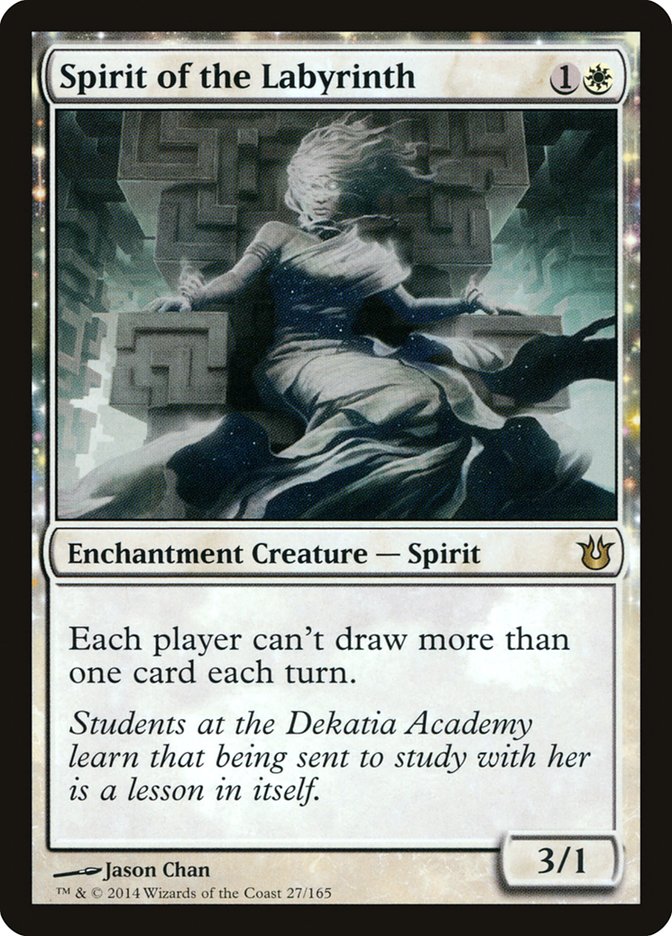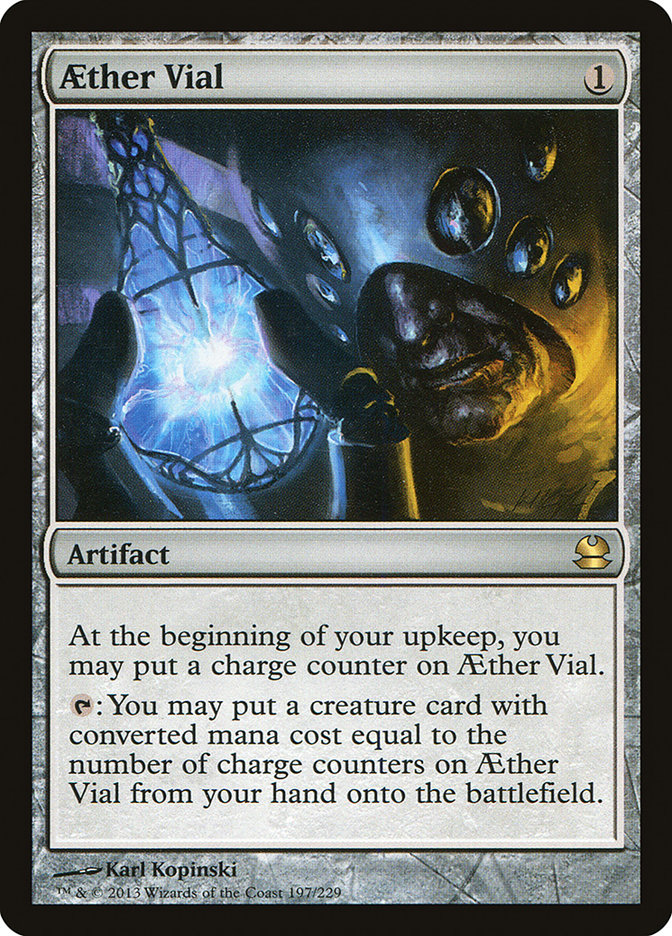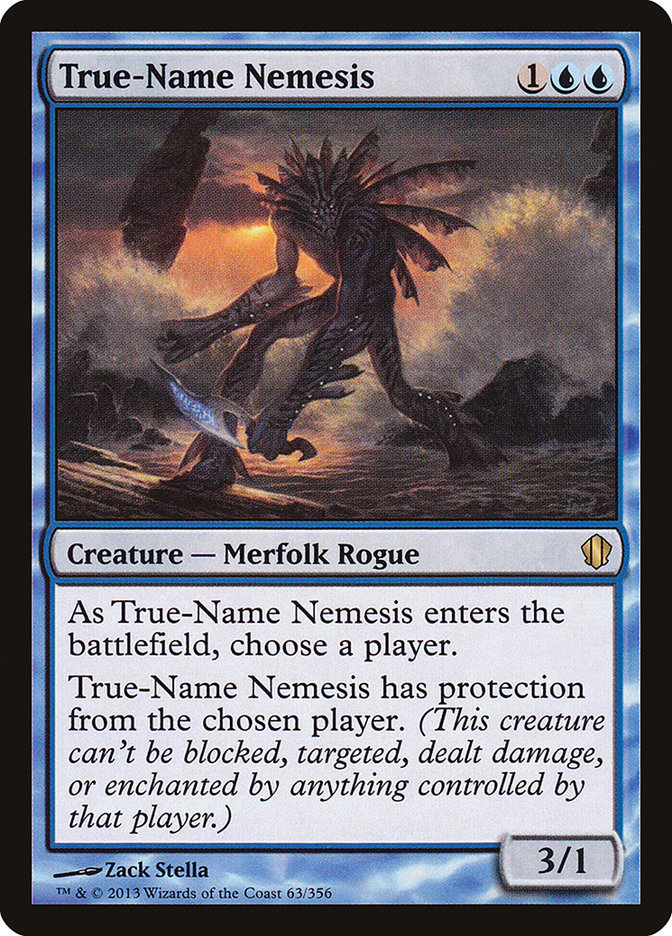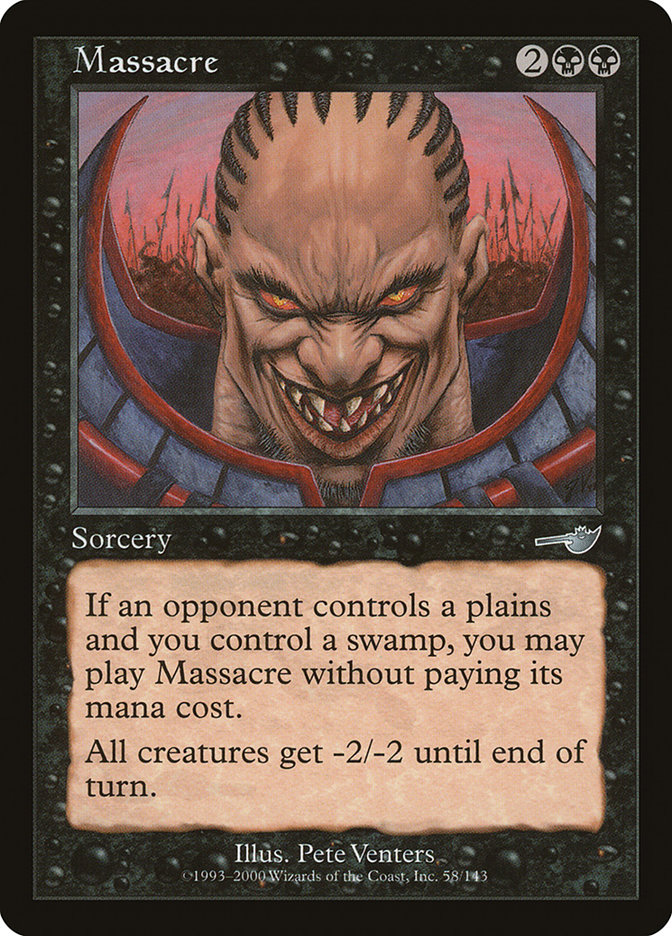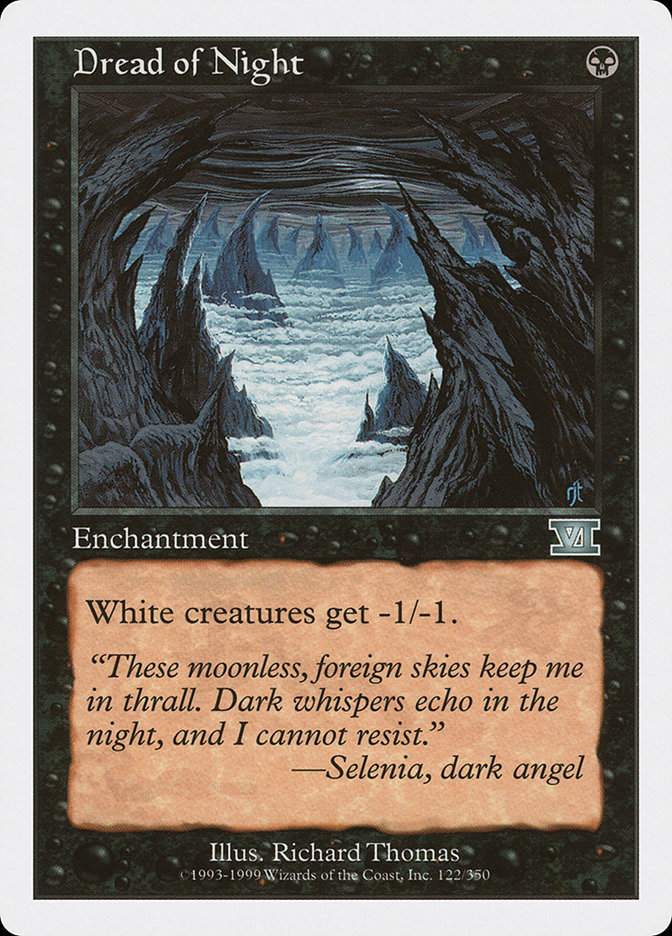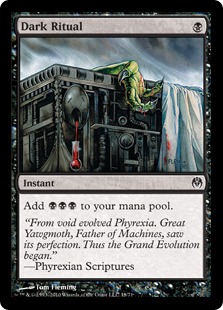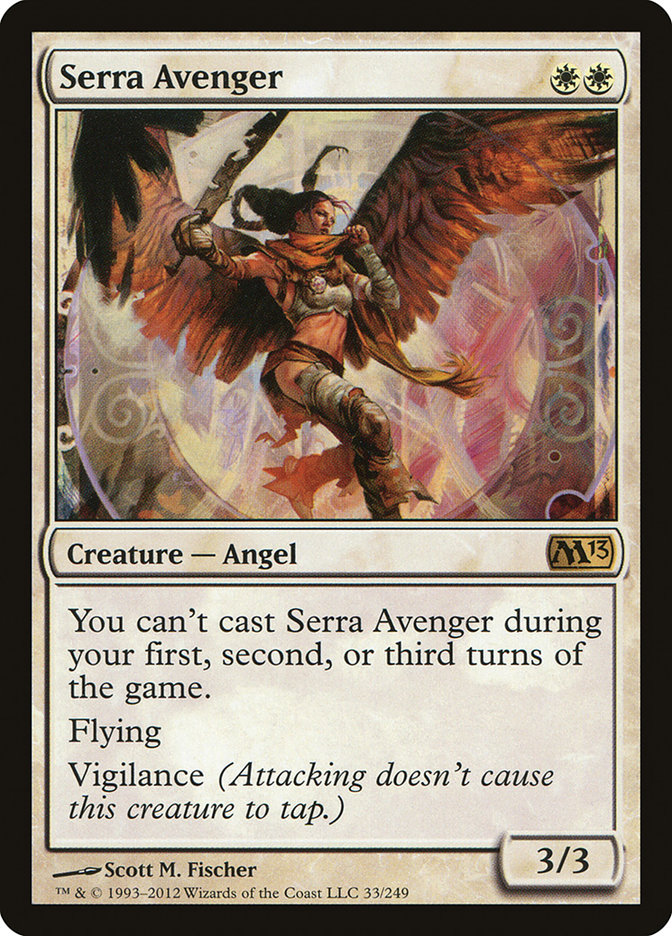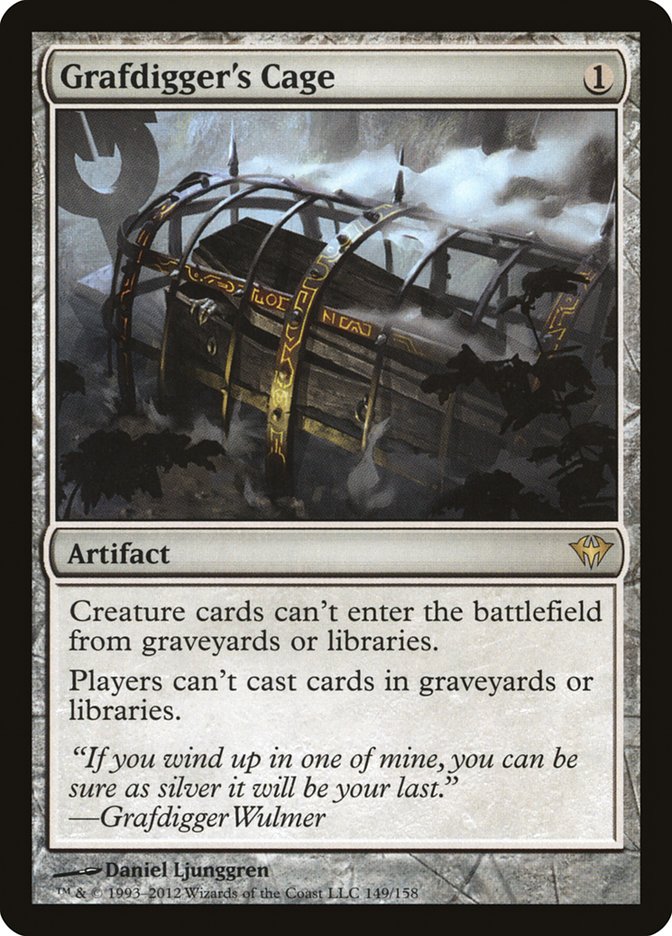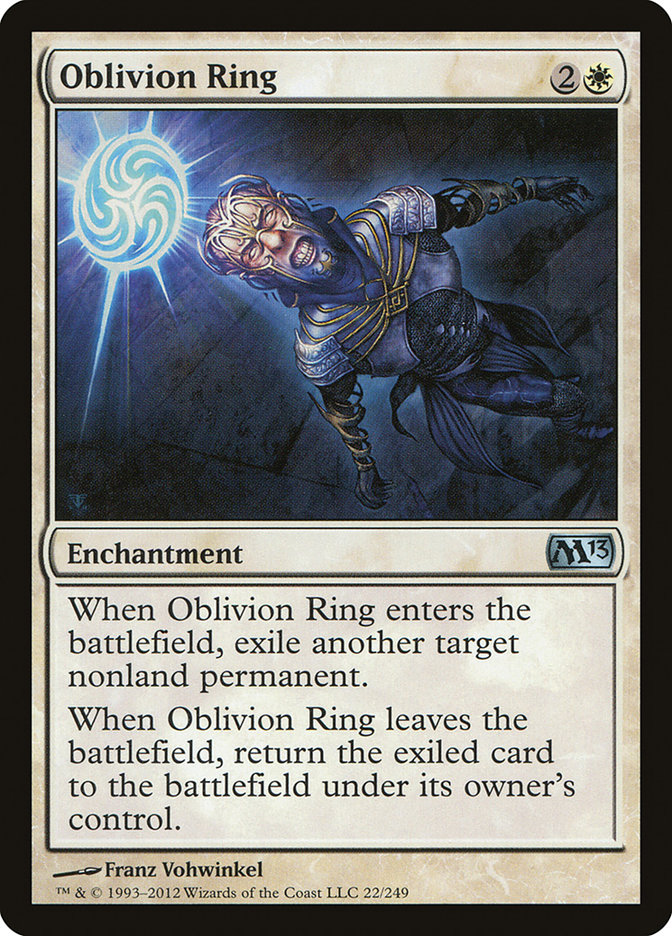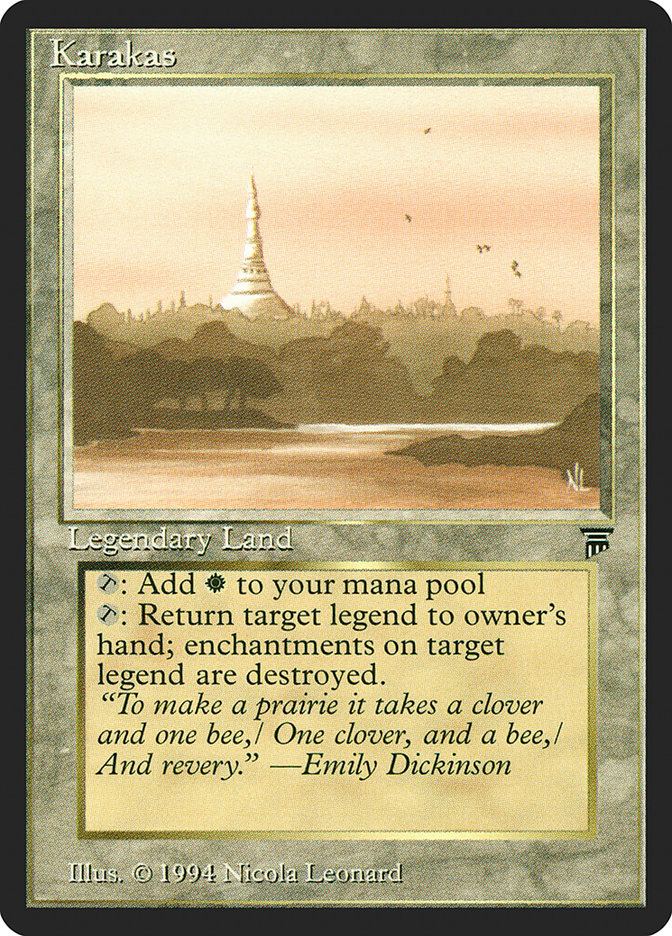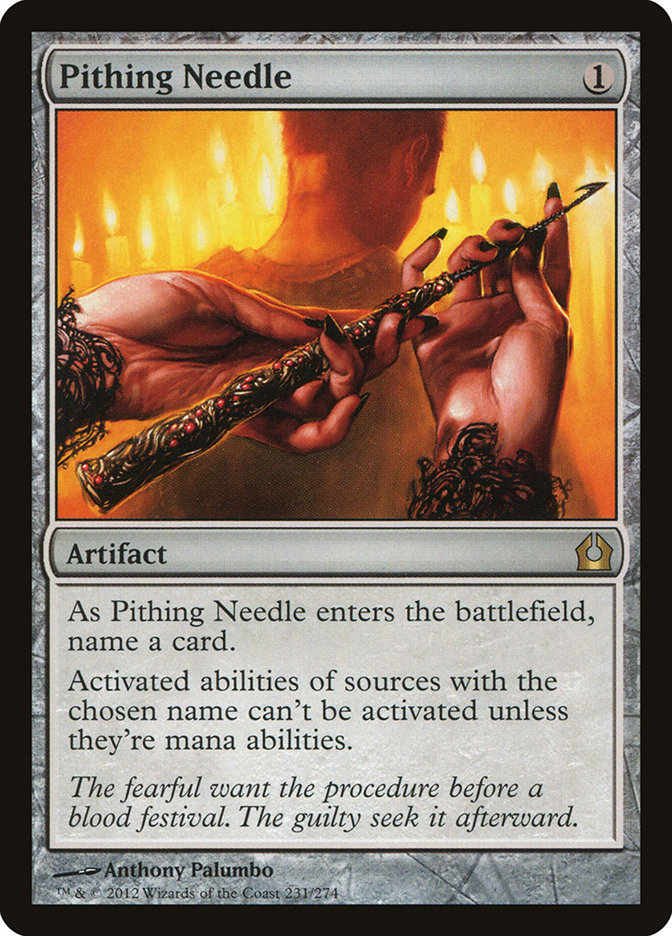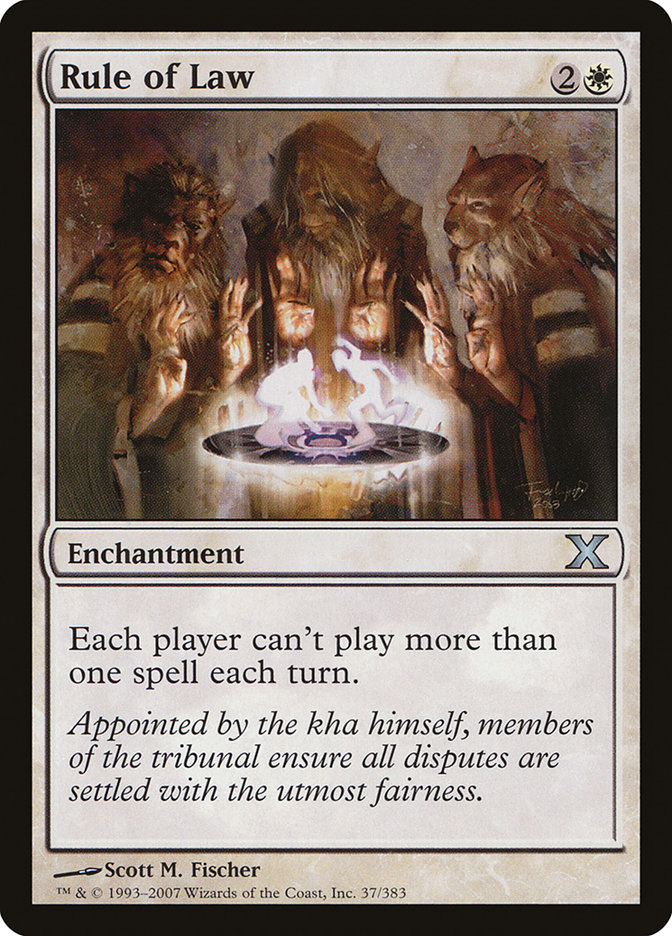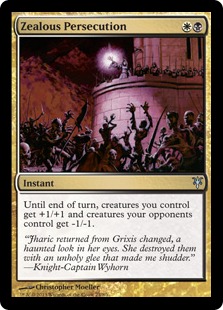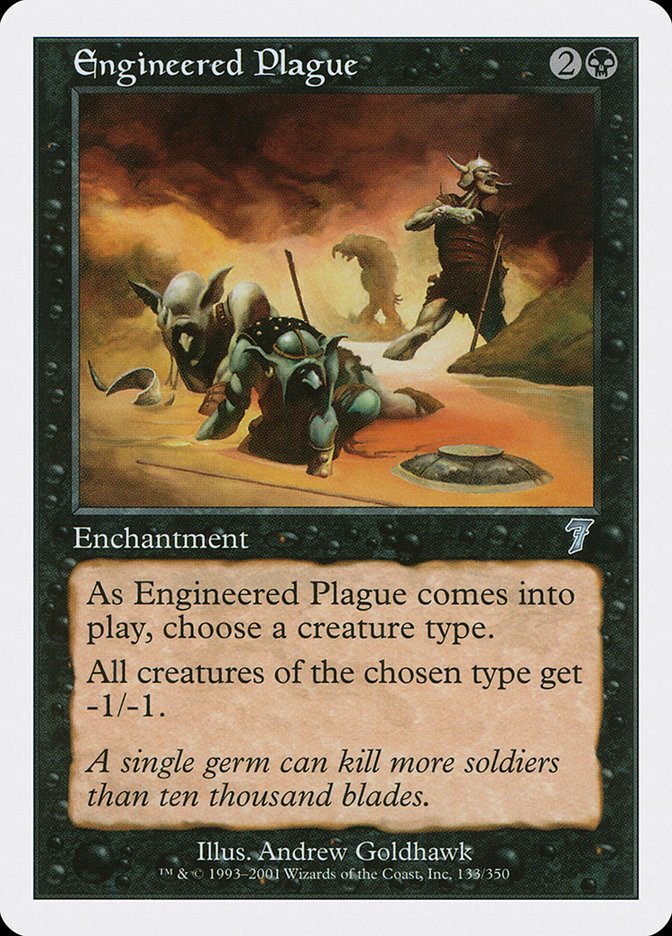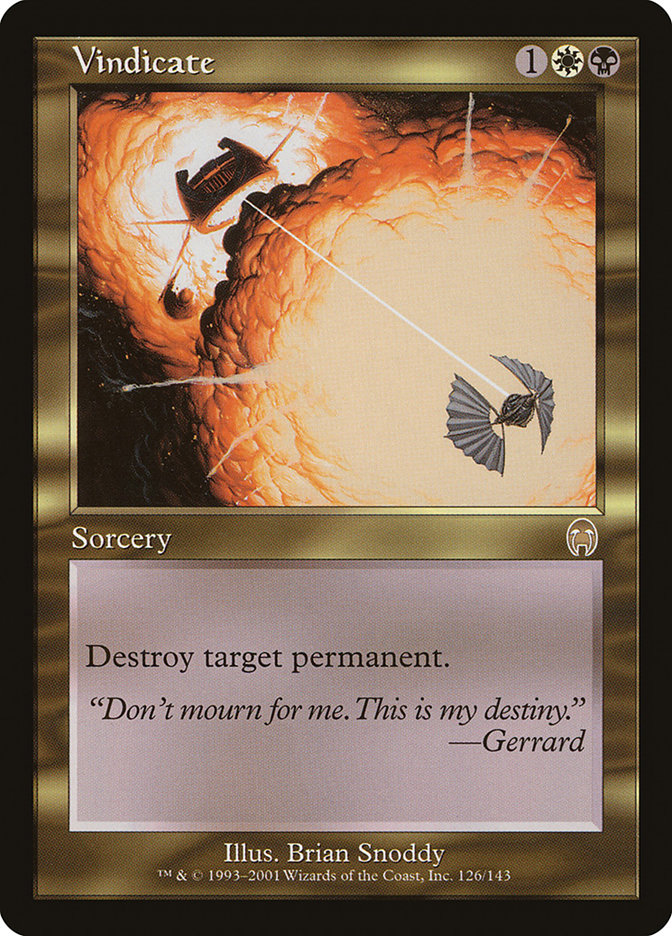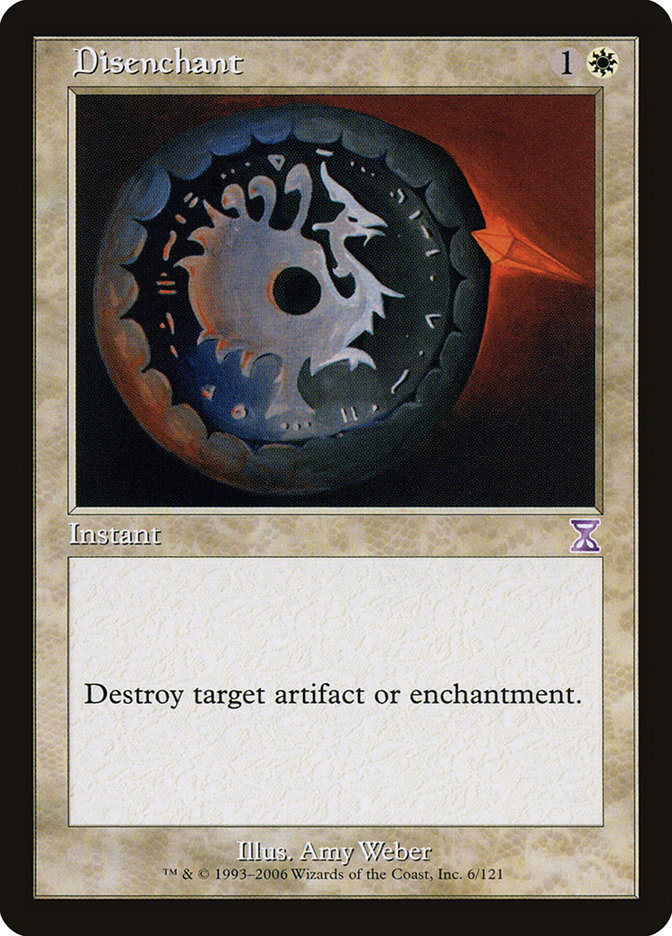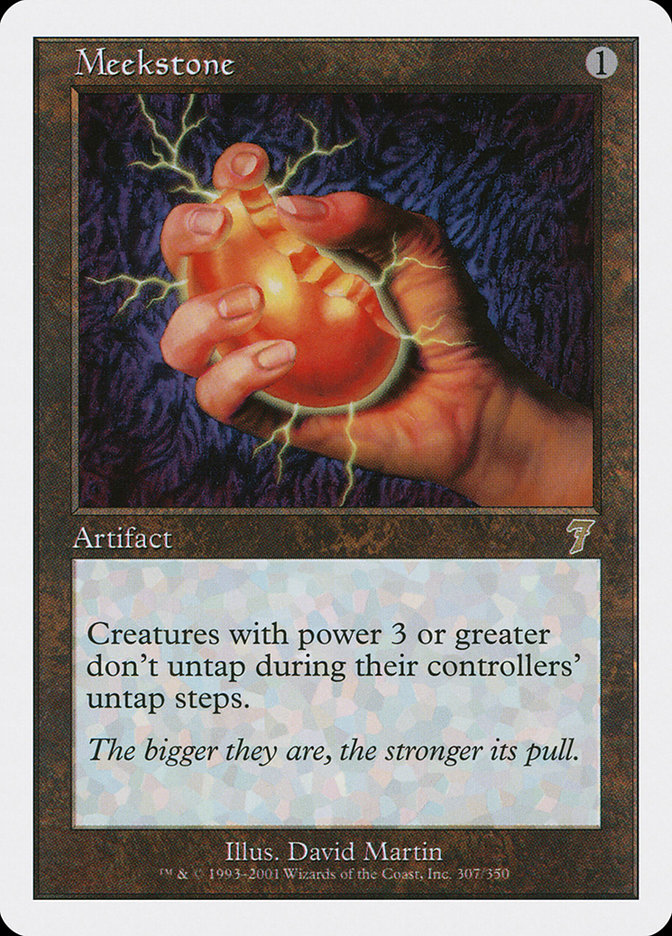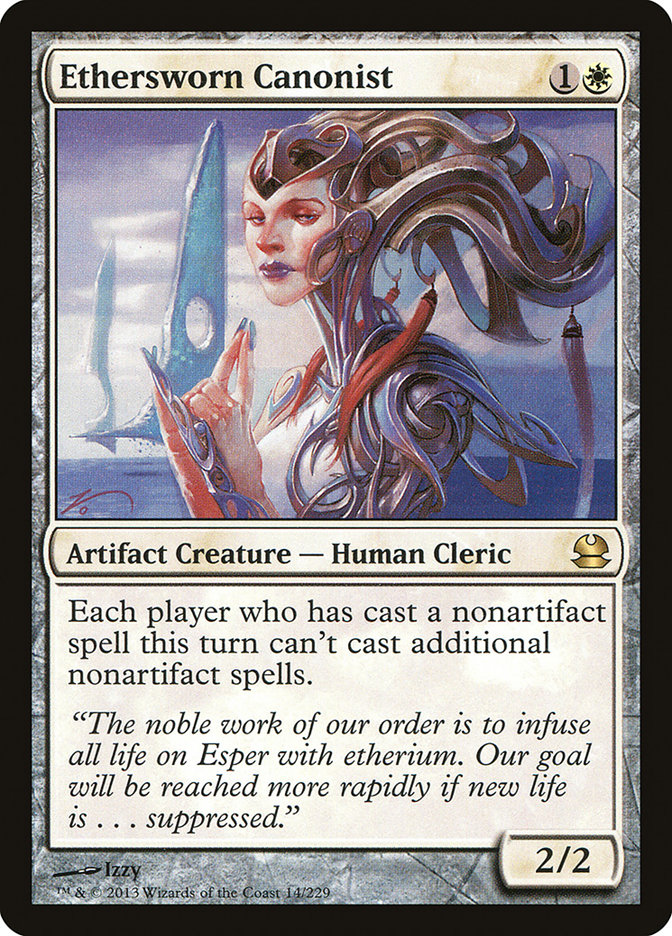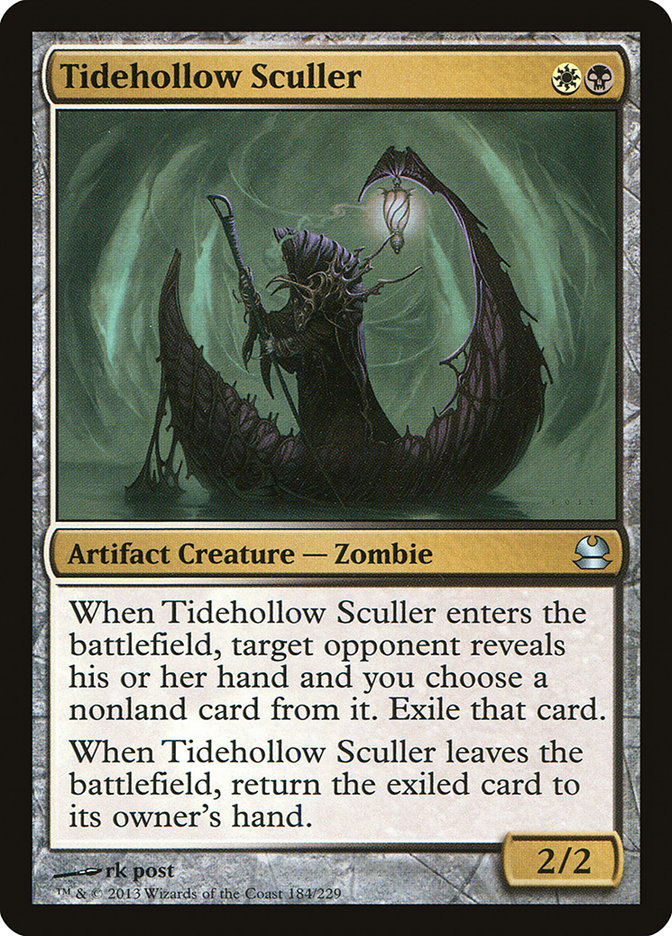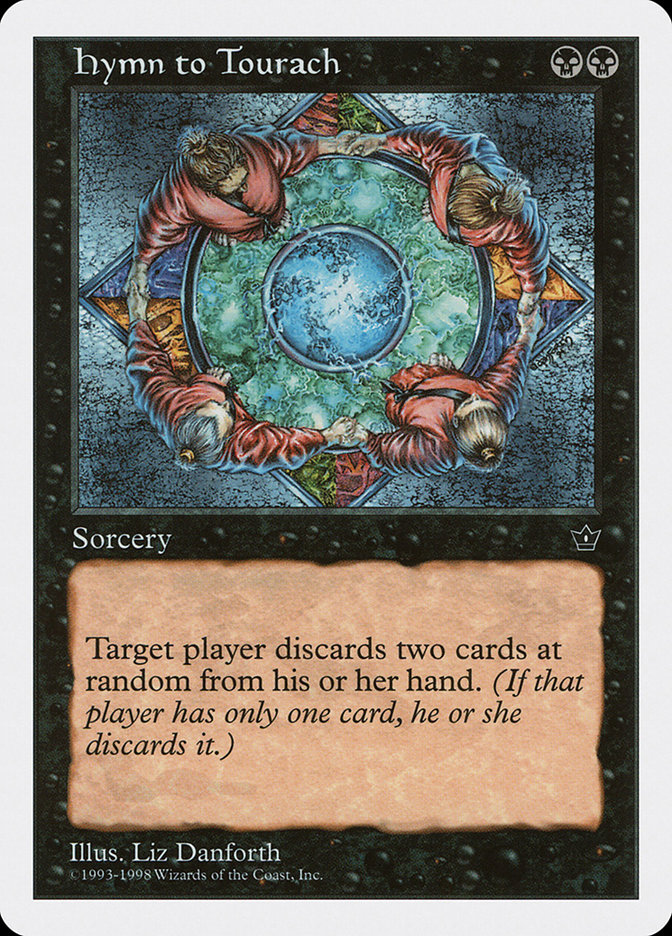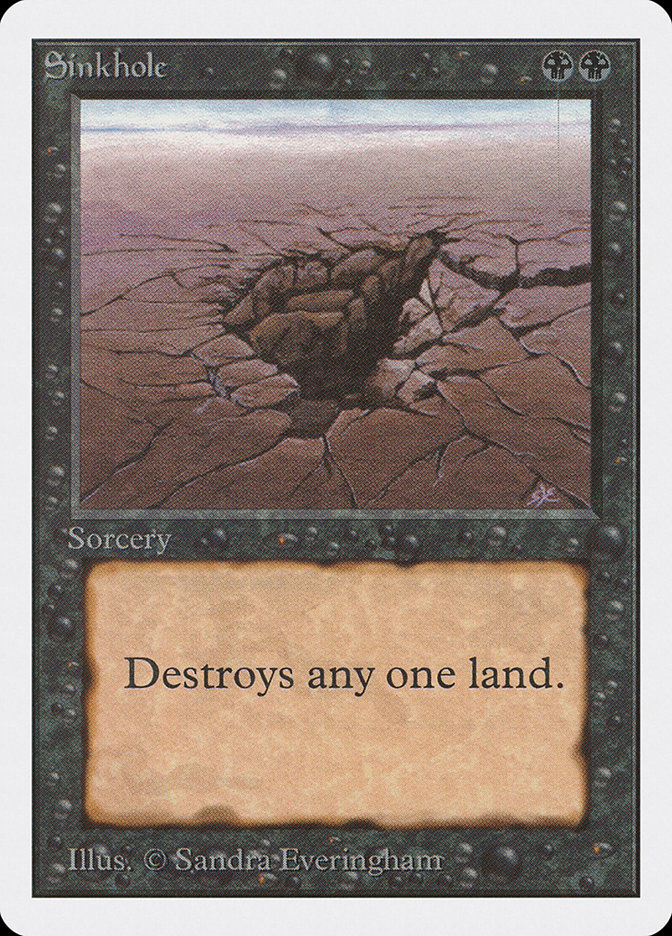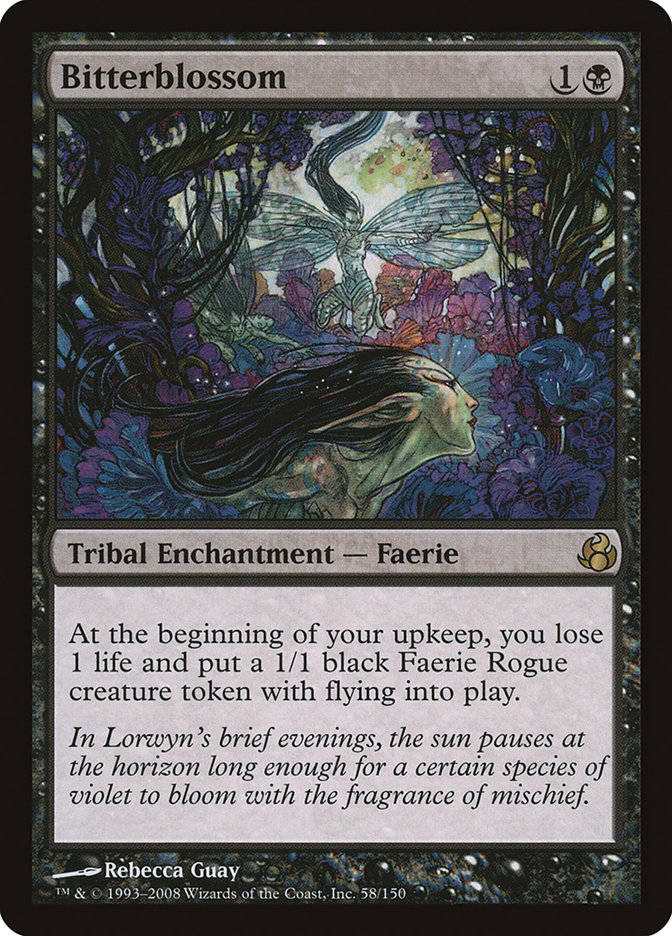Looking for an awesome deck to play in Legacy that allows you to calmly and casually grind your opponent into the dust? Do you want to play a game where you assemble piece after piece that surgically and systematically gains advantage of every kind while simultaneously making your opponent’s cards bad and ineffectual?
Well, friend, I have a deck for you to try out at your next Legacy tournament.
Creatures (24)
- 4 Mother of Runes
- 4 Dark Confidant
- 2 Serra Avenger
- 4 Stoneforge Mystic
- 3 Thalia, Guardian of Thraben
- 4 Deathrite Shaman
- 3 Spirit of the Labyrinth
Lands (22)
Spells (14)

First things first, don’t be mad at me because I promised to play combo in Legacy and showed up here to talk about my new Death and Taxes deck splashing black. I know I said I was going to keep on keeping on with combo, but when I said that I didn’t know that new cards would enable a sweet prison deck.
No worries, I still have Sneak and Show sleeved up and ready to roll on a moment’s notice.
This W/B grindy creature deck may also invite comparisons to the Dead Guy Ale deck. Obviously, all W/B decks seeking to play with the best possible cards will have some overlap. That being said, I view this particular deck as an extension of Death and Taxes rather than Dead Guy Ale. A lot of the cards that specifically signify Dead Guy Ale are intentionally absent (Tidehollow Sculler, Vindicate).
I wouldn’t have a problem with categorizing this deck as one thing or another. In my book, it is just a W/B creature deck, all silly labels be damned.
So I strayed from playing my usual combo deck to work on a new disruptive aggro deck in Legacy, and the biggest draw was to put one very a-maze-ing Spirit into play.
A little ghost can make a large impact.
Ever since I saw Spirit of the Labyrinth on the Born of the Gods spoiler list, I knew it is the kind of card that I want to cast in Legacy.
As you may well already know if you have read my articles for a while, I harbor a slight grudge against the Eternal banned and restricted lists in regard to certain busted, format-warping, clearly head and shoulders better than everything else cards continuing to avoid the ban hammer.
One thing that I have been consistent about is that if ridiculous cards (Brainstorm in Legacy and Bazaar of Baghdad in Vintage for example) are going to be legal as "build around me’ cards in Eternal formats that Wizards ought to print better efficient and playable cards that are good against these types of strategies.
Spirit of the Labyrinth (or Rest in Peace in Vintage) is one of those cards, and it makes me very happy to own cardboard copies of this little dream come true. So today I am not complaining about old policies but applauding a fantastic new printing and looking forward to unlocking and experiencing new possibilities in Legacy!
Death and Taxes seems like the perfect home for Spirit of the Labyrinth, as the deck already takes on an aggro-prison role in most matchups. Spirit of the Labyrinth fits into this role since it has a great power to mana ratio at three for two and has a very relevant disruptive ability for a format defined by Brainstorm and Ponder.
The other thing that I love about Spirit of the Labyrinth in Death and Taxes is that Aether Vial can create situations where an instant speed Spirit of the Labyrinth can actually win the game on the spot. If a player simply casts a Spirit of the Labyrinth, the opponent can adjust, and it creates a situation where they will not cast their draw spells until after they deal with the Spirit.
The dynamic changes when one adds flash and uncounterable to the equation. If an opponent casts a main phase Brainstorm and you are able to Aether Vial down a Spirit in response, they essentially get three-for-oned, as they cannot draw a card with Brainstorm (essentially countering it) and then they will have to put two cards from their hand back on top of their library.
Is Sol Ring good? Well, if you add Cavern of Souls and Winding Canyons to a Sol Ring, you end up with an Aether Vial.
Aether Vial is a card that I have been really excited to play with since I started working on my Dark Death and Taxes deck. The card is off the charts powerful but demands a lot from one’s deck construction. The key is that one needs to play a lot of creatures in order to take advantage of the pseudo-mana production and positional advantage that Aether Vial affords by putting creatures into play for free in the face of counterspells and at instant speed.
Another element built into this archetype that makes Aether Vial completely over the top powerful is the fact that it allows us to put creatures on the board while using our lands to attack our opponent’s ability to produce mana. Essentially, a draw that has an Aether Vial doesn’t necessarily require our lands to produce mana and allows us to use them instead to attack our opponent’s mana.
Last week I very easily won a game where the only spell I had the mana to cast in the first five turns was an Aether Vial. I played turn 1 Vial off a Wasteland and Wasteland my opponent three times in a row.
The first thing that I will point out about the deck is that it is chockfull of cards that I would say are individually A+ power rating Magic cards: Dark Confidant, Stoneforge Mystic, Thoughtseize, Aether Vial, Mother of Runes, Wasteland, Rishadan Port, Umezawa’s Jitte, Swords to Plowshares, and Deathrite Shaman.
The deck is full of cards that a knowledgeable Legacy player should be looking to play in the first place.
Let me explain how I came to play this Death and Taxes splashing black deck in the first place. I played the stock mono-white Death and Taxes deck in a local Legacy tournament and pretty much immediately identified some weaknesses in the deck.
Cards that prey on the fact that it is just a white creature deck really punish the Death and Taxes strategy.
One thing that I quickly realized was that the very thing that makes Death and Taxes a good deck—all of the benefits of being a creature deck where the creatures work together to create synergies and deny resources—is also a liability. If my opponent was very fast and could win before I got my creatures down, I lost. If my opponent had a sweeper, I lost.
I also ran the risk of running out of cards and drawing worse off the top of my deck than opponents who had Brainstorm and Ponder to smooth out their draws in topdeck wars.
I feel like all of these problems and weaknesses are addressed by adding black to the deck. In particular, having the ability to Thoughtseize the opponent is extremely important. With Thoughtseize, not only can the W/B pilot take whatever their opponent’s best card is, but the information is also invaluable when playing a resource denial deck.
When you know what your opponent has (or what they don’t have), it allows you to tax their resources more efficiently. For instance, if you know they will be able to play more lands and cast something anyway, it might be better to cast a spell like Stoneforge Mystic on your turn to gain positional advantage, whereas in other situations it might be better to Wasteland or Rishadan Port their mana so that their turn doesn’t progress their board.
Thoughtseize is also a card that carries a lot of weight against fast combo decks, which were a problem for the mono-white version of the deck. Being able to take a key Dark Ritual or Lion’s Eye Diamond to buy time to deploy Thalia, Guardian or Spirit of the Labyrinth is absolutely critical, and being able to take Massacre post-sideboard is also a big deal.
Have you ever wondered what a one-mana hybrid-cost planeswalker might look like?
Another thing that I noticed about Death and Taxes was that because the deck wants to attack the opponent’s mana base, Deathrite Shaman is extremely useful at powering my opponent’s deck through my ability to Wasteland and Rishadan Port their lands.
Deathrite Shaman is a ridiculously powerful Magic card. It is the kind of card that I look for excuses to put it into my Eternal decks, and most of the time the inclusion of the card (by virtue of its raw power level, utility, and flexibility) improves the quality of my deck.
The cool thing about Deathrite Shaman in Death and Taxes is that in the early to midgame it can function as a Rishadan Port for opposing Deathrite Shaman. If you simply don’t use it on your turn, you create a scenario where you eat opposing lands in response to your opponent trying to use their Shaman. Since you have Aether Vial and your cards are probably cheaper than theirs, this advantage is not contrary.
Deathrite Shaman is also pretty awesome against a True-Name Nemesis that is playing defense and holding back your creatures on the ground since you can make them lose two life every turn. It provides a way to clock opponents even if you cannot attack profitably. Of course, it is another invaluable resource against graveyard-based decks like Lands and Dredge as well. It also doesn’t die to Dread of Night, which is cute.
As I said, it provides so much power, flexibility, and utility that adding it to a deck is apt to make the deck much better.
Nothing grinds out advantage quite like a Bob.
Ask any Magic player what the best creature ever printed is, and if they didn’t say Deathrite Shaman, chances are they said Dark Confidant. (Both creatures are very good reasons to be splashing black in a creature deck.)
Dark Confidant is good enough to make the cut all on his lonesome, but his synergy with Spirit of the Labyrinth is a big load of icing on top of the cake. Since Confidant says to reveal a card and put it into your hand, it doesn’t technically count as drawing a card and thus doesn’t get taxed by the Spirit’s ability.
So Dark Death and Taxes has a card advantage engine that sidesteps Spirit of the Labyrinth’s drawback completely!
Do we really need to discuss why Stoneforge Mystic is good in a primarily white creature-based strategy?
Moving on . . .
When looking at my version of Death and Taxes, you will probably notice that I have cut the three-drops completely from it. It seemed fairly intuitive to me to do so when I added black to the deck. For one, the deck replaces three-drop creatures for one- and two-drops that are simply better for less cost! The other thing I really like is that when piloting this deck you never need to make a decision whether or not to tick Aether Vial up to three because all of the threats cost two mana.
The Littlest Dragon
I’ve heard a lot of chatter that Serra Avenger isn’t any good in Death and Taxes. I initially left the card in over Flickerwisp, Mangara of Corondor, or Aven Mindcensor simply because it costs two mana and is easier on Aether Vial.
My expectations based upon what I’d read was that the card would be bad and that once I’d experienced that for myself I’d cut it and move on. The truth of the matter is that in this build the card has overperformed and wildly exceeded my expectations. It is great at attacking with Umezawa’s Jitte and playing defense (much like True-Name Nemesis), and the evasion is fantastic in a ground stall. It has also come up quite a few times that it is invaluable at trading with (or ambushing with Mother of Runes in play) a Delver of Secrets that was winning a race.
The Sideboard
The sideboard should be fairly straightforward, but nonetheless I will go over some of the choices. Most of these cards have been selected to gain an edge in the combo matchups that I think are the most difficult.
Graveyard Hate
Nothing gives me more pleasure than absolutely stomping an opponent who enjoys dredging Golgari Grave-Troll. It’s a maniacal personal preference, but when I’m playing Eternal formats, I want those young men and women who think it’s fun to play with Stinkweed Imp and Narcomoeba to reevaluate their lives after they’re done playing a match against me.
Carryover Rule From Vintage #1: Don’t skimp on the Dredge hate because you will inevitably regret it.
Graveyard decks are powerful, and it doesn’t cost a ton to gain a lot of percentage against them by using a significant chunk of one’s sideboard. Since W/B doesn’t have a ton of card selection or filtering like a Brainstorm deck would, it is important to increase our chances of drawing our hate cards when we need to (primarily in our opening hand).
Rest in Peace is amazing against decks that need their graveyard to progress their game plan: Tin Fins, various Lands and Loam decks, Dredge, Reanimator, and even Ad Nauseam Tendrils. It is also not unreasonable to board in Rest in Peace against blue decks that have a lot of graveyard shenanigans going on: Deathrite Shaman, Tarmogoyf, Snapcaster Mage, Nimble Mongoose, Life from the Loam. Sure, it shuts down your Deathrites, but it might make it very difficult for them to actually be able to win the game.
I generally shy away from playing nombos my decks, and Rest in Peace plus Deathrite Shaman qualifies as one. However, the amount of damage that Rest in Peace causes for certain strategies is well worth the risk. For instance, I wouldn’t hesitate to board in Rest in Peace against a deck like Punishing Jund because it will nuke their Punishing Fire, Deathrite Shaman, and Tarmogoyf. Getting the enchantment against certain decks may make it very difficult for them to actually be able to play the game and return the axis of play back to one that is much more favorable for us.
Note: Remember that because the dredge mechanic is a replacement effect that Spirit of the Labyrinth’s ability will not stop the opponent’s additional draws/dredges from Breakthrough, Faithless Looting, or Cephalid Coliseum. Don’t make the mistake of leaving them in against Dredge; they are essentially just a 3/1 with no text against it.
Combo Hate
The maindeck features some cards that are not very good against combo decks, so we look to improve our matchup post-sideboard by removing cards specific to creature decks like Swords to Plowshares and Mother of Runes in lieu of combo-specific disruption:
Cards for combo.
Duress is a pretty good catchall card for most combo decks, and I don’t mind being overloaded on this type of effect. I ended up cutting Ethersworn Canonist because I wanted my permanent hate cards to not be creatures.
Mother of Rune proof sweepers like Massacre and Toxic Deluge seem to be the direction that ritual-based combo has moved to attack Death and Taxes, so I’d rather attack them on a different axis. Black for Thoughtseize and Duress is one way of accomplishing this, and Rule of Law is another. It is likely if you stick it (we can turn 2 it with Deathrite Shaman) that they are dead on the spot.
One of the matchups where we lost a little bit of ground is against Sneak and Show, and Karakas, Pithing Needle, and Oblivion Ring are for that deck specifically.
Creature Hate
In general, Mother of Runes is an absolutely crazy card in a creature mirror match. However, there some creature decks that fight us on an axis where Mom isn’t going to be enough all on her own, so from the sideboard she gains the aid of some pretty hateful anti-creature spells.
The Orzhov dispatch Merfolk with extreme prejudice.
In an all-out creature war, opposing decks that utilize a tribal theme (Merfolk, Goblins, Elves, Minotaurs, whatever) tend to be the most problematic. The ability of these decks to produce a lot of bodies quickly and buff them with lords can lead to W/B’s smaller disruptive creatures ending up too small and too slow.
The other card that can be a real pain in the Orzhov’s side:
Nemesis the Menace
The fact that True-Name Nemesis can play effectively on offense and defense can create a big problem for Dark Death and Taxes that is further complicated by the fact that W/B doesn’t have the ability to counter this annoying fish.
Zealous Persecution and Engineered Plague are both fantastic answers to tribal and True-Name Nemesis decks and thus warrant space in the sideboard.
One interaction that I have been very impressed by is that of Spirit of the Labyrinth against Elves. I know that before Spirit of the Labyrinth that the Elves deck was a very difficult matchup for Death and Taxes because the types of disruption (Thalia, Guardian of Thraben; Phyrexian Revoker; Aven Mindcensor) that it played were conditional and not the greatest at stopping the green mage from going all Godzilla on us.
Spirit of the Labyrinth is fantastic at shutting down the Elvish Visionary plus Wirewood Symbiote draw engine as well as completely blanking the Glimpse of Nature combo route.
On The Fringe Of Getting In
75 cards is not a ton of space for a Legacy deck when one considers that nearly every card ever printed is an option or a possible strategy somebody might try to use against us.
Here are a few of the cards that are on my radar as possible substitutions for Dark Death and Taxes as well as an explanation for why they didn’t make the cut this time around.
A lady who loves to tax the game.
Liliana of the Veil is a fantastic card, and I wouldn’t fault anybody for finding room for a couple of copies in the deck. She attacks an opposing player’s resources with her +1 ability and shrinks their board with her -2.
My biggest concern with Liliana was the BB color requirement in a deck that plays four copies of Rishadan Port, four copies of Wasteland, two copies of Karakas, and a Plains. I do acknowledge that Deathrite Shaman in the deck makes playing this card much more realistic, but I have been so impressed with the deck as is that I didn’t want to start tinkering too much.
Raw power and versatility are a deadly Legacy combination, so making room for this card may be a worthy endeavor.
The only way to make things right is to destroy your best card right now.
Vindicate is a very good card, but it’s often not a great one. It offers a ton of flexibility but at a pretty significant mana cost. In a format full of "snap kill it" one-drops like Delver of Secrets and Deathrite Shaman, True-Name Nemesis, and Daze, I just don’t want to overpay for the effect.
The original classy catchall card.
It may very well be wrong to not include a copy of this card in the sideboard as a catchall. My problem with a miser’s Disenchant is that a deck like Death and Taxes doesn’t tutor so the odds of finding it at the right time are unlikely. My thought process is that if I need to Disenchant a card, in a majority of scenarios I will be able to Duress or Thoughtseize it, and hand disruption is more useful a significant amount of the time.
My creatures are puny, so I deserve some payoff.
Meekstone is all upside against Tarmogoyf, True-Name Nemesis, and Delver of Secrets. I wouldn’t fault somebody for wanting to play with Meekstone, and if I expect a lot of this type of BUG and RUG decks, I may well sleeve one up myself.
I’m going against the written word of how to sideboard against combo with W/B by excluding these fine cards.
Ethersworn Canonist is one of the best cards at doing what it does against Storm and other ritual decks. My problem with the card is that it overlaps a strong axis that I already bank hard on. The deck already has problematic creatures to disrupt combo decks (Thalia, Guardian of Thraben and Spirit of the Labyrinth), so I anticipate my opponents bringing in cards like Massacre, Toxic Deluge, or Pyroclasm.
Therefore I prefer that my other hate cards be unanswerable by the sideboard cards that my opponents are likely to bring in. Nothing is worse than losing to a Massacre with a Thalia, Guardian of Thraben; Spirit of the Labyrinth, and Ethersworn Canonist on the board. I don’t want to lose when I draw my sideboard cards because they are easily answered.
Give me Duress any day of the week, and give me a card like Rule of Law (or Thorns of Amethyst perhaps) that I can slam and actually end the game on the spot.
Back in Suey Black?
I am not playing these fantastic spells because they don’t overlap with my mana very well, but I could see building a version of the deck that goes the heavy black route instead of the white road.
Lorwyn’s most hateful flower.
Good card is good. Good enough? Unforeseeable.
Bonus Decklist Time!
Here is a B/W deck that basically plays half of the cards that Dark Death and Taxes doesn’t play. Instead of establishing itself on the heavy white side of the spectrum, this list plays more black spells in order to utilize powerful spells like Liliana of the Veil, Hymn to Tourach, and Sinkhole.
Creatures (14)
Planeswalkers (2)
Lands (22)
Spells (22)
- 1 Sensei's Divining Top
- 1 Umezawa's Jitte
- 4 Hymn to Tourach
- 4 Swords to Plowshares
- 4 Sinkhole
- 2 Vindicate
- 4 Thoughtseize
- 1 Bitterblossom
- 1 Batterskull
Sideboard

Do you like casting Sinkhole and Hymn to Tourach and driving all of your opponents completely insane? Well, here’s a deck that does that pretty darn well.
Decks like this require tight play and proper planning in order to execute their strategy, but I have found that they give players a very good chance for a good tournament performance.
Unlike combo decks, which earn a lot of free wins from running players over, B/W Stoneblade gives you a lot of close matchups and not very many outright bad matchups. A deck like this is comparable to Jund in that all of the cards are individually powerful, which gives the pilot a lot of relatively even matchups. No great matchups, but also no terrible matchups.
B/W Stoneblade really needs Necropotence. The DCI should make a rule that you can play the skull as long as your deck also includes zero copies of Brainstorm or Underground Sea.
Death and taxes may be inevitabilities of real life, but in Magic I’m pretty sure that it is equally inevitable that adding Thoughtseize, Dark Confidant, and Deathrite Shaman to most decks makes them better.

